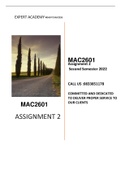EXPERT ACADEMY ROAD TO SUCCESS
MAC2601
Assignment 2
Second Semester 2022
CALL US :0833851178
COMMITTED AND DEDICATED
TO DELIVER PROPER SERVICE TO
OUR CLIENTS
MAC2601
ASSIGNMENT 2
,
, al
QUESTION 1
INDEPENDENT PART A
Calculate the manufacturing overheads per unit for both Rocky and BMY bikes
using activity-based costing.
Rocky BMY
Machining costs
(2 623 050/375 x 150); (2 623 050/375 x 225) 1 049 220,00 1 573 830,00
Assembling costs
(2 250 000/37 x 7); (2 250 000/37 x 30) 425 675,68 1 824 324,32
Quality inspections
(5 265 000/75 x 15); (5 265 000/75 x 60) 1 053 000,00 4 212 000,00
Stores receiving costs
(2 610 000/1044 x 369); (2 610 000/1044 x 675) 922 500,00 1 687 500,00
Stores issues costs
(3 065 023/1630 x 650); (3 065 023/1630 x 980) 1 222 248,44 1 842 774,56
TOTAL 4 672 644,11 11 140 428,89
Overhead cost per unit
(4 672 644,11/826); (11 140 428,89/2 040) 5 656,95 5 460,99
Explain a difference between the traditional costing and activity -based costing
methods.
Non-manufacturing (ie customer support costs), as well a s manufacturing costs,
may be assigned to products for decision -making purposes (not for GAAP
inventory valuation).
A number of overhead activity cost pools are used, each of which is allocated to
products and other cost objects using ABC’s own unique meas ure of activity or
driver.
The allocation bases differ from those used in the traditional costing method.
The activity rates may be based on the level of activity at normal capacity rather
than on the budgeted level of activity.




